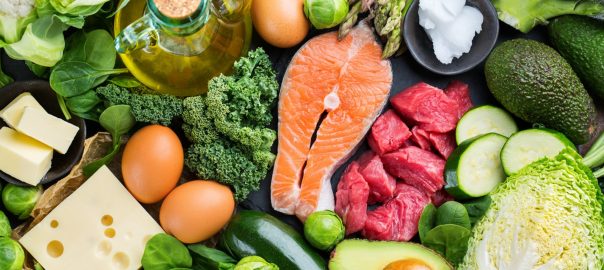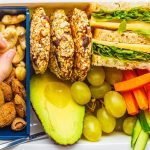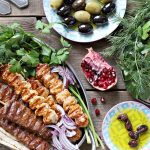
Keto Diets & Food Choices
How to do a “Clean” Keto Diet
Learn why you might be going about your ketogenic diet in an unsustainable way and how you can choose clean, high quality, nutrition-packed foods instead.
Disclaimer: The information in this article is not intended to replace personalized medical advice. A low carb diet may not be suitable for you. Consult your health care provider before making any changes to your lifestyle or use this information at your own risk.
The keto diet is infamous for those seemingly indulgent foods that you are “allowed” to eat while following one. While these ideas about getting your daily fat intake from butter, bacon and cheese are technically sound, this may not be the best way to go about a ketogenic diet – especially if you plan to do it for a long time – as it can pose many threats to your overall health. Although you will likely get into ketosis and notice weight loss while eating these foods, you could also notice things like acne, more frequent illness, weak nails, brittle hair, and other signs of an unhealthy internal system.
There is a way to do a keto diet the “clean” way, and it is important to understand that this is the most sustainable and sensible way to do a low carb diet. It’s not just about the macros – it’s also about what you are putting into your body. Do the foods you eat contain enough nutrients to fuel the complex machine that is your body? Do they cause or prevent inflammation? Will they increase or decrease your risk or certain diseases that you may be simultaneously trying to manage?
In this article, we debunk a lot of the common beliefs about popular “keto foods” and provide you with guidelines for how to meet the needs of a ketogenic diet with clean, healthy foods, instead. We will explain what these foods are and how you can incorporate them into your diet in tasty and convenient ways. Ultimately, our goal is to encourage a healthy style of intuitive eating, whereby you know and feel what works best for you and your body and feel confident in your ability to achieve weight loss and other health goals.
Debunking Popular “Keto Foods”
We’ll start with the most important macronutrient category for keto dieters – fats! Getting your daily fat requirements can be tricky at first and knowing where to get the best quality fat from can be even more difficult. Unfortunately, mainstream nutritional sciences have advised against consuming high fat foods if you want to lose weight for decades. While we now know that this is not true, and that consuming healthy fats is an essential part of any diet, we still might not be clear on the right kinds of fats to eat.
When we think of fatty foods, some of the first things that come to mind are butter, cheese, yogurt, bacon, fatty cuts of meat, etc. While it’s true that these foods contain high amounts of fat, they are not the healthiest forms of fat that we can be consuming.
Let’s start with dairy. There is some controversy around whether things like butter and cheese are healthy. These foods are high in saturated fats, which have long been associated with cardiovascular disease because they are linked to high cholesterol levels. However, the real reason these foods can increase levels of cholesterol is because they come from animals. Animals, like humans, produce all of the cholesterol their bodies need. However, since we humans consume animal foods, we are also consuming the cholesterol stored in their meat and dairy. So, the problem is that we end up with extra cholesterol in our bodies by consuming the cholesterol that animals’ bodies produce. The fact that these foods contain saturated fats is not the real issue; there are also plant sources of saturated fats (such as coconut oil), which do not negatively impact our cholesterol levels. To learn more about cholesterol, check out our article “Exploring Cholesterol Level Impacts on Health.”
The key to choosing the right animal foods is all about sourcing. Look for meat and dairy from grass-fed cows, as these contain higher amounts of nutrients, lower cholesterol levels, and more heart-healthy omega-3 fatty acids. Choosing butter or ghee that is grass-fed instantly makes it one of the healthiest fat choices. Both of these are ideal for cooking at high temperatures because they have a high smoke point. On the other hand, traditional grain-fed butter is highly inflammatory, contains few nutrients and is made using unethical and unhygienic (more prone to E. coli infection) farming practices. If you don’t have access to grass-fed dairy and meat, it may be best to avoid it altogether.
Next, let’s dive into popular keto proteins, particularly fatty cuts of meat and processed meats such as bacon and sausages. Protein isn’t a huge part of a ketogenic diet, comprising only about 20% of your daily caloric intake. So, it is important to ensure that when you are consuming protein, that you are consuming the right kinds.
Almost everything in our bodies is made up of some type of protein! Proteins are a key component of our cells, tissues, hormones and enzymes. The building blocks of proteins are amino acids, and there are 9 essential amino acids. Foods that contain these 9 essential amino acids are called “complete proteins” and include things like fish, meat, eggs, dairy and whole sources of soy (tofu, tempeh, edamame and miso). Incomplete proteins may include things like whole grains, legumes and nuts.
Since you won’t have many chances to get your protein in each day on a keto diet, be sure to choose the best protein sources you can manage. And, ensure that the quality of these complete proteins is the best you can find. Avoid all kinds of processed meats (sausages, bacon, deli meats, hot dogs, etc.) which contain unnatural preservatives and fillers – and sometimes even hidden carbs such as sugar! These meats have also been linked to increased risk of cancer, heart disease and diabetes because of these additives.
Always choose meat that is farm-raised, free-range, wild-caught and grass-fed. Finally, you don’t need to choose fatty cuts of meat just because you follow a ketogenic diet. Other sources of fat are much healthier, as we described earlier. When choosing meats, focus on lean portions that provide your body with a clean, complete sources of protein and have your fats on the side.
Finally, we encourage you to read our article about the healthiest cooking oils to use. Although they are often overlooked, cooking oils play a big role in our gut health, inflammation levels, and risk for chronic diseases. As a keto dieter, oils are probably a key part of your diet, so be picky about the ones you use!
Clean Keto Foods
So, now that you know what to avoid, let’s discuss what you should be consuming a on a clean keto diet.
Focus your meals around healthy plant-based fats or grass-fed animal fat. In addition, load up on non-starchy vegetables as these will help keep you full and provide your body with many essential nutrients. For protein, focus on lean cuts of meat also from best sourcing practices. Look for grass-fed beef, free-range chicken and eggs, and wild-caught fish. You can also get some protein and healthy fats from vegan and vegetarian sources such as nuts, seeds, tofu, tempeh, and dairy from grass-fed cows.
Below are lists of “clean” foods within each macronutrient category that you should be sure to include in your keto diet:
Fats
- Unrefined/Extra virgin coconut oil (organic if possible)
Tip: “Unrefined” and “extra virgin” terms indicate that the oil has undergone minimal or no processing to ensure all of the original nutrients are preserved.
- Extra virgin olive oil
- Organic, grass-fed butter or ghee
- Flaxseed oil (ideal for salad dressings, not for cooking)
- Avocados and avocado oil
- Raw nuts (walnuts, almonds, pecans, macadamia nuts, brazil nuts) or nut butter
- Raw seeds (pumpkin seeds, chia seeds, hemp seeds, ground flax seeds) or seed butters such as sunflower seed butter and tahini (sesame seed butter)
- Full fat coconut cream/milk (for stews, curries and soups)
- Olives
- Unsweetened dark chocolate (70% or higher)
Tip: Grinding flaxseeds into a meal allows the nutrients within the outer casing of the seed to be absorbed better by our bodies.
Protein
- Tofu
- Tempeh
- Free-range poultry and eggs
- Wild caught fish (especially fatty fish such as salmon, mackerel, tuna, sardines and anchovies)
- Grass-fed beef
- Organ meat such as liver, which is high in several vitamins and minerals
- Game meat
- Unsweetened protein powders made from whey, pea, brown rice, or hemp protein
- Collagen peptides – a key protein involved in anti-aging!
- Bone broth
Carbs
- Leafy greens such as spinach, swiss chard, kale, arugula, beet greens, etc.
- Cruciferous vegetables such as broccoli, cauliflower, cabbage, and Brussels sprouts
- Mushrooms
- Zucchini
- Asparagus
- Celery
- Cucumber
- Radishes
- Bell peppers
- Sprouts
- Tomatoes
- Citrus fruits
- Berries
On top of all of these foods, you can also use a variety of herbs and spices to add more flavour to your dishes. These typically contain few or zero carbs and even have many healing properties!
Clean Keto Recipes
Below, you’ll find some easy recipes to help you get started with your new “clean” keto diet! All of these recipes contain healthful ingredients and are quick and easy to prepare. In general, focus on recipes that use whole foods and don’t rely too heavily on “crutch” ingredients like butter and cheese for flavour. When in doubt, keep things simple! A go-to meal could just be some cooked protein, washed and sliced mixed veggies with a drizzle of extra virgin olive oil, lemon juice and seasonings, and a side of nuts, avocado or even some dark chocolate!
Breakfast
- Keto Chia Seed Pudding
- Low Carb Flaxseed “Oatmeal”
- Keto Salmon Avocado Toast (bread recipe included, or use a store-bought keto-friendly bread)
- Keto Veggie Egg Muffins
- Easy Keto Pancakes serve with nut butter or sugar-free keto syrup!
Lunch
- Keto Chicken & Veggie Lunch Meal Prep (note: we recommend using this “clean” keto mayonnaise made with avocado oil from Primal Kitchen)
- Salad with veggies, olives, clean protein and Fat Burning Salad Dressing
- Keto Chicken Salad sandwich on low carb bread
- Instant Pot Bone Broth
Dinner
- Chimichurri Steak with Keto Grilled Veggies
- Spicy Almond Tofu with Cauliflower Rice
- Grilled Salmon with Avocado Salsa
- Creamy Tuscan Chicken (Dairy-Free)
- Keto Coconut Curry Chicken
Snacks/Dessert
- Keto Snack Bars (dairy and gluten-free)
- Keto Chocolate Zucchini Muffins
- Keto Vegan No Bake Fat Bombs
- Salt & Vinegar Zucchini Chips or Kale Chips
- Spiced Nuts or Sweet & Salty Trail Mix
- Cherry Tahini Energy Balls (omit raisins to make it lower carb)
Clean Keto Products
The Low Carb Grocery carries a wide selection of low carb and keto-friendly products made with clean ingredients. Here are some of our favourites:
- Anthony’s Goods premium baking and cooking ingredients
- Eve’s Crackers savoury vegan, keto, gluten-free crackers
- Glutenull Bakery keto-friendly cookies and granola
- Handfuel hand crafted nut snacks
- KZ Clean Eating high fibre keto-friendly breakfast cereals, crackers and bread mix
- Lily’s Sweets no sugar added, high fibre chocolate
- Nick’s Sticks grass-fed beef jerky sticks
Stay Connected
We hope that this article helped show the importance of good nutrition while following a low carb diet, and that you feel ready to tackle a clean keto diet! If you’re new to the keto diet, or have years of experience to share, please head over to our Facebook and Instagram pages to join the conversation!
Also, we’d love to hear your direct thoughts of The Low Carb Grocery by leaving us a Google Review. And, for the best prices on low-carb and sugar-free items, be sure to subscribe to our weekly newsletter.






